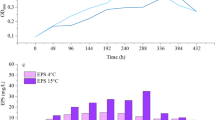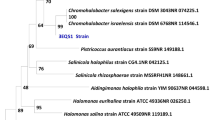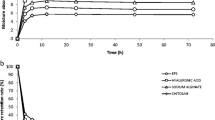Abstract
An aerobic, mesophilic and heterotrophic marine bacterium designated RA19, able to produce two different exocellular polymers and zeaxanthin, was isolated from a French polynesian bacterial mat (localy named “kopara”) situated in the atoll of Rangiroa. This microorganism, on the basis of its phenotypical features and the genotypic investigations, can be clearly assigned to the Parococcus zeaxanthinifaciens species and the name Parococcus zeaxanthinifaciens subsp. payriae is proposed. Optimal growth occurs between 30°C and 35°C, at pH between 6.5 and 7.5 and at ionic strength between 20 and 40 g/L of NaCl. The guanine-plus-cytosine content of DNA was 65.6%. This bacterium excreted, under laboratory conditions, two different polymers: a water-soluble exopolysaccharide (EPSI) consisting of 5 different sugars and a non-water-soluble macromolecule assumed to be of a glycoproteinic nature. The high sulfate content of the EPS1 and preliminary biological tests clearly showed that applications could be found in the very near future for both polymers in the cosmetic area. Their contribution to the viscous laminated microbial mat locally called “kopara” can be also mentioned.
Similar content being viewed by others
Author information
Authors and Affiliations
Rights and permissions
About this article
Cite this article
Raguénès, ., Moppert, ., Richert, . et al. A Novel Exopolymer-Producing Bacterium, Paracoccus zeaxanthinifaciens subsp. payriae, Isolated from a “Kopara” Mat Located in Rangiroa, an Atoll of French Polynesia. Curr Microbiol 49, 145–151 (2004). https://doi.org/10.1007/s00284-004-4303-x
Issue Date:
DOI: https://doi.org/10.1007/s00284-004-4303-x




